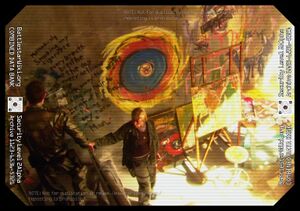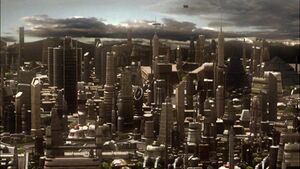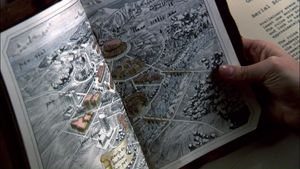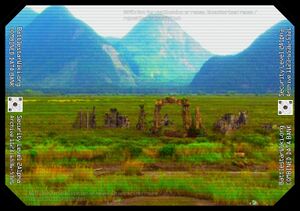Arts and Literature of the Twelve Colonies
| |||||
The Twelve Colonies, like most civilizations, produce objects not merely utilitarian. They have supported literature, including genre pieces, and poetry, allowing for unusual grammatical constructs. Several newspapers are based in various cities, and they have freedom of the press. Colonials have painting, even abstract designs not strictly representative of their reality. They have a variety of musical traditions, as well.
Additionally, many functional items produced on the Colonies adhere to an aesthetic, even at cost to effeciency.
| |||||
You have found a link that leads nowhere... deliberately.
Reasons?[edit]
The reason for this is to clean up the Special:Wantedpages, thus making our lives easier behind the scenes.
So, what links lead here?[edit]
There are too many to bother wasting our time listing. So here's a list of pages that link here.
Literature[edit]
Prose[edit]
Edward Prima/"Dark Day"[edit]
Edward Prima is a Colonial novelist known for his book Dark Day.
Adama, who had Dark Day in his personal library on battlestar Galactica, gives it to Laura Roslin as a gift in the episode "Water". She says that she considers it to be "one of those classics I've never gotten around to reading." Given the context of their conversation, notably Roslin's reference to A Murder on Picon, it is likely a mystery.
Roslin returns the book, to Adama's consternation, after the prognosis of her disease sharply worsens in "Flight of the Phoenix".
"A Murder on Picon"[edit]
A Murder on Picon is a mystery novel, apparently taking place on Picon.
Laura Roslin brought the book with her on the trip to Galactica, (Water) prior to its decomissioning ceremonies (Miniseries).
Poetry[edit]
Kataris[edit]
Kataris was a Caprican poet[1]. Lt. Joe Palladino owns a bound edition of Kataris' poems and threatens Col. Saul Tigh with lines from one:
From the darkness you must fall
Failed and weak, to darkness all.
Kataris is quite well-known amongst colonials. Kara Thrace recognizes the quotation, recalls from which piece it comes, and knows the poem's quality relative to his other works. D'anna Biers identifies Palladino's copy of one of Kataris' books on sight in a recording she is editting (Final Cut).
Periodicals[edit]
Visual Arts[edit]
Representationalist[edit]
Monclair[edit]

Monclair was a Colonial painter. One of his original paintings, a depiction of the Cylon War, adorns William Adama's office on the battlestar Galactica (Bastille Day). He is apparently of considerable renown, given Gaius Baltar's impressed reaction to the piece.
Abstract[edit]
Kara Thrace[edit]

Between tours of duty, Kara Thrace was an enthusiastic painter. Karl Agathon is surprised to discover this side of her when they visit her apartment in Delphi (Valley of Darkness).
Sculpture[edit]
In addition to the Arrow of Apollo, the Delphi Museum of the Colonies contains a large collection of ancient pottery. Located in numerous display cases in the exhibit halls spanning the museum's levels, this large collection of vases, jars, pots and stone fragments form a rough outline of the Colonials' artistic history. Many of the artifacts and art pieces are quite elaborate and appear to be in the detailed Corinthian Style.
Music[edit]
Dreilide Thrace[edit]
Kara's father was a pianist. His daughter kept recordings of some of his piano arrangements in her Delphi apartment (Valley of Darkness).[3]
Colonial Anthem[edit]
Forthcoming - use of Colonial Anthem/Original Series theme (by Stu Phillips) in "Miniseries", "Final Cut"
Aesthetics[edit]
Colonial aesthetics lead to an avoidance of right angles.
Octagons[edit]
Colonial printouts, photographs, and videos are rarely rectangular; the corners are trimmed at 45 degree angles, creating snub rectangles, i.e octagons. The reasoning for this is likely based on their aversion to right angles, as rectangles are, particularly for paper, more efficient.
Hexagons[edit]
In the Re-imagined Series, hexagons feature significantly as "ID" tags, playing cards, glass bottles and many other objects. This likely reflects both the dislike of right angles and the simplicity of polygons over curved shapes.
Architecture[edit]
Federal Period[edit]

This style was mix of older and newer trends, utilizing traditional stone facades along with glass and steel. This architecture was found throughout Caprica City, Delphi, and other Unnamed Cities of Caprica prior to the Cylon attack.
Ancient Kobol[edit]


In Kobol's Last Gleaming, Part I, Roslin looks at schematics for the City of the Gods on Kobol. Its buildings, such as the Temple, Forum, and the Opera House, were made of stone and range in shape and size, and resemble classical Greco-Roman architecture.
Later, we are given a glimpse of the ruins of the Opera House when Gaius Baltar and others crash-land nearby. The building was made of stone and utilized decorative columns and pillars. While there, Baltar has a vision which may have represented the original appearance of the Opera House before it fell into disrepair.
Polygonal Architecture[edit]
Many places and objects within Galactica reflect early aesthetic choices that eschew right-angular forms. Many corridors, including ship bulkhead doors, are hexagonal. CIC elements, particularly the Command & Control Center table, the tactical station table, and even the alignment of the displays of the DRADIS console, form a hexagonal appearance.
This aesthetic appears to have waned during the construction of more advanced battlestars such as Pegasus, which uses far fewer hexagonal shapes.[4]
Notes and References[edit]
- ↑ The name "Kataris" is probably a reference to the Roman poet Catullus.
- ↑ The original production art is available at Galactica Station.
- ↑ The piece attributed to Kara's father is actually Metamorphosis One, composed by Philip Glass, from his 1989 album Solo Piano.
- ↑ The sets for Pegasus were purchased from a failed series pilot for a "Lost in Space" remake. As such, the sets adhere to "earthly" rectangular design, and budget constraints for "Battlestar Galactica" likely limited any large modifications.

